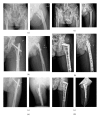Internal fixation of intertrochanteric hip fractures: a clinical comparison of two implant designs
- PMID: 23476148
- PMCID: PMC3588189
- DOI: 10.1155/2013/834825
Internal fixation of intertrochanteric hip fractures: a clinical comparison of two implant designs
Abstract
Objective: To compare two internal fixation devices clinically in stabilisation of intertrochanteric femur fractures.
Methods: Eighty-seven patients were randomised upon their admission to the hospital using a sealed envelope method. Forty-five were treated with proximal femur nail antirotation (PFNA) and 42 with reverse less invasive stabilisation system (LISS). The perioperative data were recorded and compared in relation to fracture type.
Results: In each type of fractures, no significant differences were found with respect to the blood loss, the quality of reduction, the time to bony healing, and the Harris hip score between the 2 groups. The mean duration of surgery was significantly longer in reverse LISS group than in PFNA group.
Conclusion: Both the PFNA and the reversed LISS are effective in the treatment of different types of intertrochanteric femur fractures. PFNA is superior to reverse LISS in terms of surgical time, weight-bearing, and perhaps fluoroscopy time.
Figures



References
-
- Kokoroghiannis C, Aktselis I, Deligeorgis A, Fragkomichalos E, Papadimas D, Pappadas I. Evolving concepts of stability and intramedullary fixation of intertrochanteric fractures-A review. Injury. 2012;43:686–693. - PubMed
-
- Ma CH, Tu YK, Yu SW, et al. Reverse LISS plates for unstable proximal femoral fractures. Injury. 2010;41:827–833. - PubMed
-
- Zha GC, Chen ZL, Qi XB, Sun JY. Treatment of pertrochanteric fractures with a proximal femur locking compression plate. Injury. 2011;42:1294–1299. - PubMed
-
- Oh CW, Kim JJ, Byun YS, et al. Minimally invasive plate osteosynthesis of subtrochanteric femur fractures with a locking plate: a prospective series of 20 fractures. Archives of Orthopaedic and Trauma Surgery. 2009;129(12):1659–1665. - PubMed
-
- Pryce Lewis JR, Ashcroft GP. Reverse LISS plating for proximal segmental femoral fractures in the polytrauma patient: a case report. Injury. 2007;38(2):235–239. - PubMed
Publication types
MeSH terms
LinkOut - more resources
Full Text Sources
Other Literature Sources
Medical

